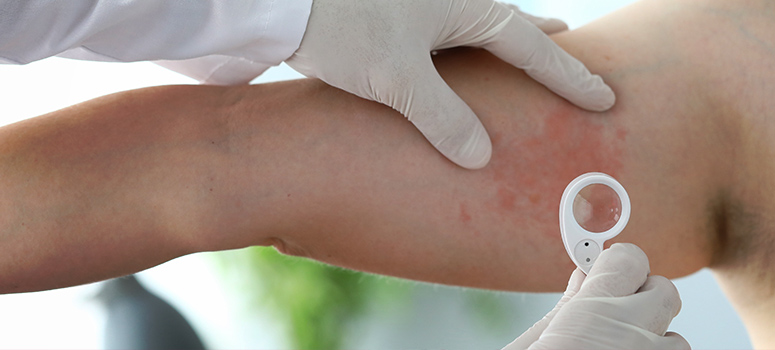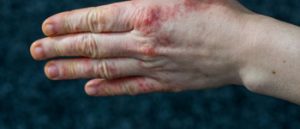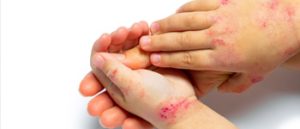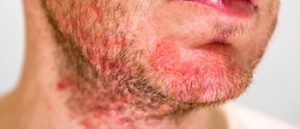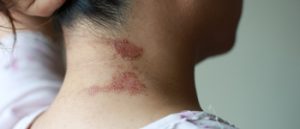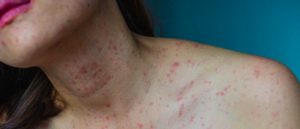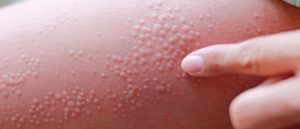What is Dermatitis?
The term dermatitis refers to different types of skin inflammations. Patients with dermatitis suffer from dry, swollen, and red skin. The symptoms and causes of dermatitis vary from person to person, but it is not contagious.
Skin inflammation due to dermatitis can be very uncomfortable, and the itching on the skin ranges between mild to severe. Dermatitis can result from an overactive immune system, contact with irritating substances, allergies, or infections.
Some kinds of dermatitis are usually seen in children, while others are more common among grown-ups. Usually, taking medications and skincare tips prescribed by your doctor can help relieve symptoms of dermatitis. Patients must always consult the doctor if signs of dermatitis are seen.
Common Dermatitis Symptoms
Dermatitis symptoms vary from person to person, and skin inflammation looks different depending on the body’s affected part. Following is a list of some common symptoms of dermatitis.
-
Dry, cracked skin
-
Mild to severe itchiness
-
Swelling
-
Rashes
-
Redness
-
Blisters
Different Types of Dermatitis
Below is a list of some common types of dermatitis
Dyshidrotic Dermatitis
In this type of dermatitis breakout, the skin is unable to protect itself. The skin appears dry and often gets small blisters. This condition typically affects parts of the hands and feet.
Atopic Dermatitis
This skin condition is also termed eczema and usually develops during infancy. Individuals having eczema are likely to suffer from dry and itchy skin.
Seborrheic Dermatitis
It is more common in babies, and it affects the scalp area. This skin condition can also affect parts of the face and chest. Scaly patches and redness are symptoms of this skin condition.
Contact Dermatitis
Contact dermatitis affects a person when some irritant substance comes in contact with the skin. It results in irritation and allergic inflammation. The skin reaction can aggravate into rashes that itch, sting and burn.
Who All can Get Affected By Dermatitis?
- Persons of any age can get affected by Dermatitis.
- Babies usually get diaper rash and cradle caps.
- Atopic Dermatitis is common during childhood, but it can affect individuals of every age.
- Contact dermatitis can affect anyone who comes in contact with an irritant.
- Persons who have celiac disease are affected by Dermatitis Herpetiformis.
Multiple factors can cause Dermatitis in an individual. Following are some examples:
Causes of Atopic Dermatitis
- Family history of hay fever or asthma
Causes of Dyshidrotic Dermatitis
- Prolonged exposure to irritants or water
- Warm climates
- Excessive sweat
Causes of Contact Dermatitis
- It primarily affects people working around toxic chemicals.
- Itchiness and redness of the skin are the first visible symptoms of Dermatitis.
Which Part of the Body is Most Affected By Dermatitis?
Atopic Dermatitis can affect any part of the body, but it mainly affects parts of the hand, knees, elbow, ankles, neck, scalp, eyes, and face in adults and teens. On the other hand, Seborrheic Dermatitis and cradle cap usually affect the face, scalp, and ears.
Some kinds of Dermatitis are widespread, while others are relatively less frequent. Atopic Dermatitis affects around 2 to 4% of adults and approximately 30% of children. About 15% of people are prone to contact dermatitis. However, no form of Dermatitis is contagious.
Differences Between Eczema and Dermatitis
Eczema is a term that refers to Atopic Dermatitis. Dermatitis can be extremely painful for some people. The symptoms and seniority of itchiness vary depending on the type of Dermatitis. Some people experience a burning sensation, while others feel mild to severe itchiness in the affected area.
Treatments Include:
- Cold, wet compresses
- Steroid drugs rubbed to the skin or consumed orally
- Psoralen with ultraviolet A therapy
Causes of Dermatitis
Dermatitis is a result of an imbalance in the immune system, genetic factors, and environmental triggers.
Scientists have found that if other family members have Dermatitis, there is a higher chance of affecting them. Genetic changes are observed in such cases that involve a specific protein responsible for maintaining healthy skin.
At times, the immune system fails to maintain a balance. For persons suffering from Atopic Dermatitis, the immune system reacts even to small allergens and attends, resulting in inflammation.
Some forms of Dermatitis break out on exposure to toxic chemicals and irritants.
Environmental changes also affect and change how the skin acts as a protective barrier. It results in higher moisture loss and leads to skin inflammations. Prolonged exposure to certain types of pollutants also results in skin inflammation.
- Genetic factors
- Imbalance in the immune system
- Exposure to toxic substances
- Changes in the environment
What Aggravates Dermatitis?
Dermatitis triggers vary from person to person, and it is best to identify the cause to avoid sudden breakouts.
In some people, exposed chemical substances can trigger Dermatitis. While in others, skin inflammation can be seen when they reveal themselves to a specific environment. Dermatitis can also result due to the use of specific references and chemical cosmetics. Exposure to sunlight is also a significant cause of skin rashes.
Diagnosis of Dermatitis
Skin specialists start the diagnosis by taking a closer look at the skin of the patient. Usually, they look for symptoms of scales, dryness, redness, and rashes. Next, they interrogate the patient about symptoms and experience.
The medical consultant also keeps an eye on
- Location of the Dermatitis
- Underlying medical conditions
- Family history of dermatitis
In most cases, doctors can diagnose dermatitis by examining the skin. If there is any doubt, the patient may require to go through some blood test, skin biopsy, or allergy test.
The treatment for Dermatitis depends on their type, location, and severity. One must always take precautionary measures to avoid possible triggers of Dermatitis. Avoid applying home remedies as it can further aggravate the inflammation. Always take medication as prescribed by the medical practitioner. Although there aren’t any Dermatitis treatments that can provide a complete cure to dermatitis symptoms, therapy can help reduce the symptoms and discomfort caused due to varying degrees of dermatitis. One must always consult with a certified dermatologist while dealing with the condition and get skincare tips while managing it.

